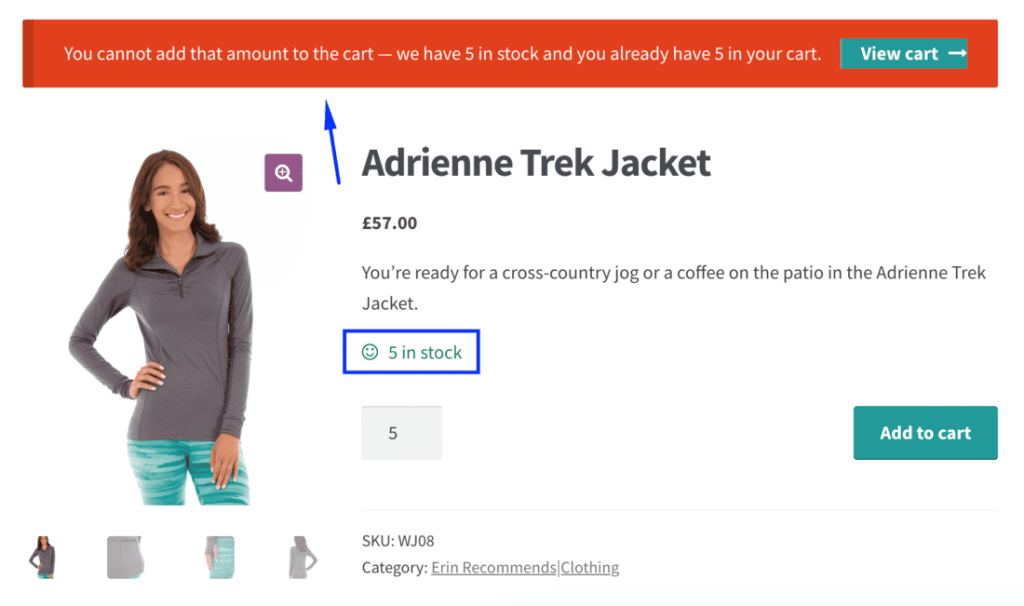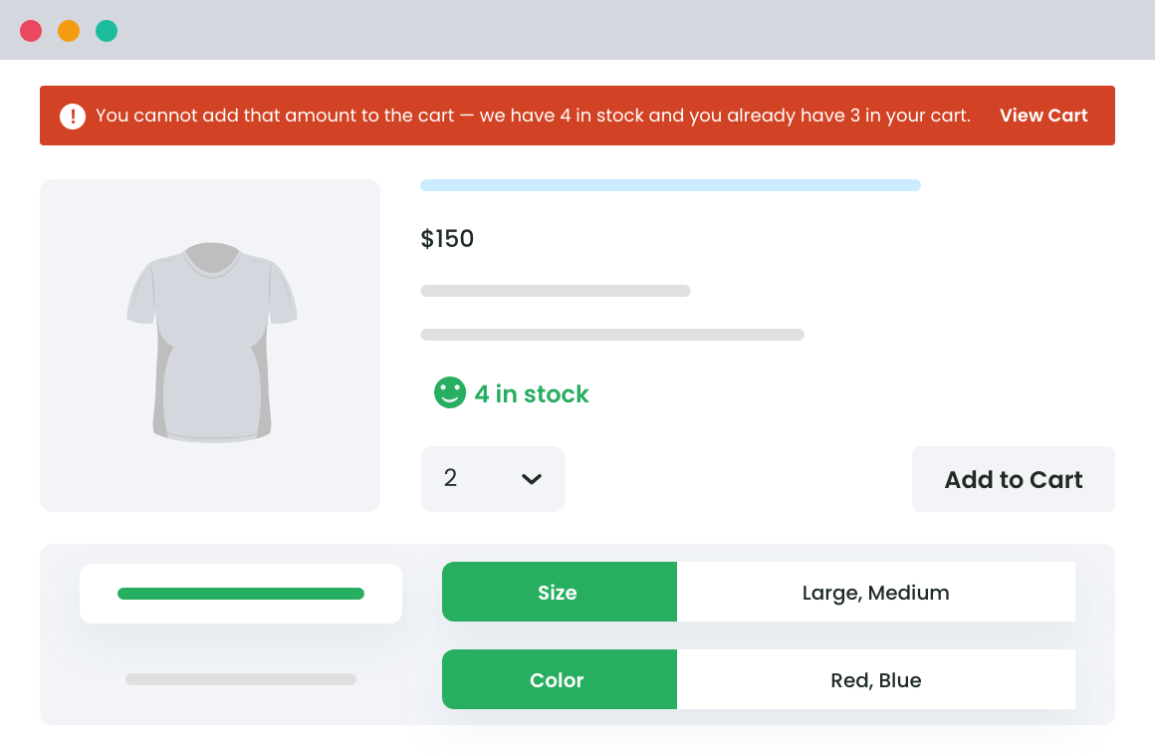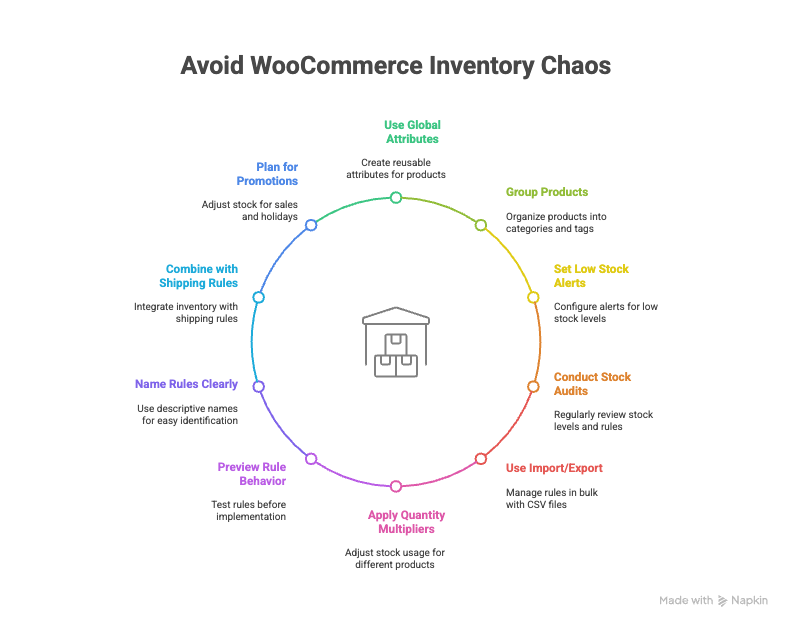Table of Contents
In this blog, you’ll learn how to manage WooCommerce attribute stock in a smarter, easier way using shared inventory rules. As a result, you avoid overselling, reduce manual work, and simplify stock tracking across product variations.
Managing inventory in WooCommerce sounds easy, until your products start having sizes, colors, or materials. Then things can get confusing fast.
By default, WooCommerce tracks each variation separately. That’s okay for small stores, but not when you have a lot of products.
For example, if your T-shirts come in five sizes and four colors, you’ll end up with 20 variations. Updating stock for each one takes time and mistakes can happen.
This kind of confusion can lead to overselling, out-of-stock errors, or unhappy customers.
There’s a better way. It’s called attribute-based stock management. Instead of tracking every variation on its own, you track stock based on shared features like size, color, or fabric.
In this guide, we’ll explain what that means, how it works, and how to set it up using the Attribute Stock for WooCommerce by Dotstore that makes WooCommerce inventory management much smarter.
What Causes Inventory Confusion in WooCommerce?
WooCommerce was made for basic stock tracking. It works well if each product is simple. But things change when products share the same parts or materials.
For example, let’s say you sell mugs. You offer them in three colors: white, blue, and black. All of them use the same ceramic material.

With WooCommerce, you have to set stock for each color separately—even though they all come from the same batch. That’s where confusion starts.
You might oversell one color without knowing the others are running low. Or you might have extra materials left over, but your store says everything’s out of stock.
This happens because WooCommerce doesn’t track shared inventory. That’s why many stores struggle as their product list grows.
What Is Attribute-Based Stock Management?
Attribute-based stock means you track inventory based on shared features, not just individual products.
Let’s take a simple case. You sell yoga mats in black, blue, and pink. All colors are made from the same foam. Instead of tracking each mat separately, you set one shared stock for the foam.
Now, whenever someone buys a mat, the foam stock goes down, no matter the color.
This makes things easier to track. You don’t have to update every variation. And you always know how much material you have left.

It’s great for stores that sell clothes, shoes, bags, or anything that uses shared materials.
The Smart Benefits of Managing Attribute Stock the Right Way
Using attribute-based stock in WooCommerce makes things easier and helps you avoid mistakes. Here’s how it helps your store:
Shared Stock for Similar Products:
If many products use the same size, color, or material, you can track all of them with one stock number. You don’t have to repeat the same stock settings for each variation.
Fewer Mistakes:
Updating each variation manually can lead to errors. Attribute-based stock means you only need to update once, and it applies to all matching products.
Clearer Inventory:
You’ll know exactly how much of each color, size, or fabric you have left. This makes it easier to plan and reorder.
No Overselling:
The system updates shared stock right away after each order. You won’t sell more than what’s in stock.
Faster Updates:
Instead of editing 10 or 20 products one by one, you set your rule once and let the plugin manage it for you.
Better Shopping Experience:
Your customers won’t see “in stock” items vanish after checkout. They’ll get what they ordered, on time, with fewer issues.
The Limits of Default WooCommerce Inventory
WooCommerce’s built-in inventory system can’t track shared stock. It treats every product and variation as separate.
That’s a problem when products have common parts. For example, if five items use the same zipper, WooCommerce doesn’t connect them. Each one needs its own stock setting, even if they all use the same thing.
This means:
- You spend more time updating stock
- You might oversell without knowing
- It’s hard to keep reports accurate
That’s why using an attribute stock plugin is the best solution.
The Best Way to Fix It: Use a WooCommerce Attribute Stock Plugin
The easiest way to manage shared stock is by using a plugin made for the job.
A WooCommerce attribute stock plugin lets you track inventory by product attributes—like color, size, or material. This works even if the products are completely different but use the same thing.
Good plugins let you:
- Set stock by attribute (like “Blue” or “Large”)
- Apply stock rules to specific products or categories
- Use quantity multipliers (if some items use more material)
- Get alerts when stock is low
With the right plugin, you save time, reduce errors, and keep your store running smoothly.
The Attribute Stock for WooCommerce plugin by Dotstore makes it easy to manage shared stock, even if you’ve never done it before.
Attribute Stock
Unlock Next-Level Stock Management with Attribute Stock Plugin.
14-day, no-questions-asked money-back guarantee.

What It Can Do:
- Track stock by size, color, fabric, or any other attribute
- Apply stock rules to single products, groups, or categories
- Use quantity multipliers if some items use more material
- Get alerts when stock is running low
- Import or export stock rules in bulk with a file
Why It’s Great:
- Works with simple, variable, and grouped products
- Clean, easy-to-use dashboard
- Saves hours of manual work
- Built for WooCommerce—no custom code needed
If you sell clothes, accessories, kits, or any product with options, this plugin is a perfect fit.
Step-by-Step: How to Set Up Attribute-Based Stock in WooCommerce
Here’s how to set it up in simple steps:
Step 1: Install the Plugin
Upload the plugin file in your WordPress dashboard under Plugins > Add New. Click Activate.
Step 2: Set Up Attributes
Go to Products > Attributes. Add shared attributes like “Color” or “Material.” Add terms like Red, Blue, or Cotton.
Step 3: Create a Stock Rule
Go to Dotstore Plugins > Attribute Stock > Add Rule.
Give it a name and set the stock quantity. Turn on low stock alerts if needed.
Step 4: Set Attribute Conditions
Choose the attributes this rule applies to. For example, “Color = Red.”
You can also use multipliers if some items use more material than others.

Step 5: Choose the Products
Apply the rule to specific products, categories, or product types. You can include or exclude items as needed.
Step 6: Save and Test
Click Save. Add a product to your cart and test a purchase. The shared stock should reduce correctly.
That’s it! You’re now using smarter WooCommerce inventory management.
Pro Tips to Avoid Inventory Chaos in WooCommerce
Even with the right plugin, smart habits will keep your store’s inventory clean and error-free. Below are detailed tips and lesser-known tricks to help you stay in control, even as your store grows:
1. Always Use Global Attributes (Not Custom Per Product)
WooCommerce lets you create custom attributes inside a product, but that causes problems later. These one-off attributes won’t show up in shared stock rules or reports.
Instead, go to Products > Attributes and create global attributes like Color, Size, or Material. These can then be reused across all your products and tracked easily by the plugin.
Hidden Tip: Use short attribute slugs (like red, large, cotton) so it’s easier to identify them later in rules and exports.
2. Group Products Using Categories or Tags Before Applying Rules
Don’t waste time selecting individual products one by one.
Organize your store using product categories like “T-Shirts” or “Ceramic Mugs.” Then apply attribute stock rules by category. This way, new products you add to the category automatically follow the rule.
Hidden Tip:: Use product tags (e.g., uses-red-ink, includes-poster-tube) if you want more flexible grouping without changing your main categories.
3. Turn on Low Stock Alerts for Every Rule
Stock might look fine today, but it can drop fast—especially during sales or peak seasons.
While creating attribute stock rules, always set a Low Stock Threshold. This sends you an email alert when the stock level hits your defined number.
Hidden Tip: Use different thresholds for fast-selling items. For example, set a warning at 30 units for “Black T-Shirt” but only 5 for “Pink Hoodie” if it sells slower.
4. Do a Stock Audit Once a Month (or Weekly if You’re Busy)
Your inventory plugin tracks stock automatically, but real-world errors can still happen. Things like damaged stock, returns, or supplier delays can throw off numbers.
Block time each month (or week) to review:
- Current attribute stock levels
- Top-selling variations
- Rules that haven’t triggered stock changes recently
Hidden Tip: Download your stock report as CSV and open it in Google Sheets. Use color filters to spot low or high-risk items at a glance.
5. Use the Import/Export Feature for Fast Bulk Changes
If you manage dozens or hundreds of products, it’s hard to update each rule manually.
Use Dotstore’s CSV import/export tool to manage all your attribute stock rules in bulk. It’s much faster than doing it one-by-one in the dashboard.
Hidden Tip: Keep a backup CSV of all your stock rules before making major changes. If something breaks, you can re-import your original settings instantly.

6. Use Quantity Multipliers for Heavy or High-Use Items
Some products use more stock than others—even if they share the same attribute.
In Dotstore’s plugin, you can set a Quantity Multiplier. This is useful if one variation uses double or triple the amount of a material.
Example: A “Poster – Large” might use 2 poster tubes, while “Poster – Small” uses 1. Set the multiplier to 2 for the large size so your shared tube stock stays accurate.
7. Preview the Rule Behavior Before Going Live
After setting a new rule, do a test run. Add products to the cart and check:
- Is the correct stock deducted?
- Are the right products included in the rule?
- Is the cart blocked if stock is too low?
Hidden Tip: Use a staging site (copy of your real store) to test complex rule combinations safely—especially if you’re running a busy store.
8. Name Your Stock Rules Clearly
As your store grows, you might have 10–50 different rules.
Use names like “Red Cotton Fabric – All T-Shirts” or “Blue Ink – Posters Only.” This helps you quickly find and edit the right rule later.
Hidden Tip: Add notes inside each rule using the “Rule Note” field. Use this space to explain why the rule exists or what to watch out for.
9. Combine With Shipping Rules for Better Profit Control
Inventory is only part of the equation—shipping also eats into margins.
Consider pairing your attribute stock plugin with conditional shipping rules (like charging more when a product needs special packaging). Dotstore also offers shipping and fee plugins that work well together.
10. Plan Inventory Around Promotions and Holidays
During Black Friday, New Year, or local festivals, your stock can drop overnight.
Use previous sales data to adjust attribute stock before the sale starts. Add buffer stock for fast-selling sizes or colors.
Hidden Tip: Create duplicate rules for seasonal bundles or special product kits that use the same stock (e.g., a “Winter Combo Pack” and individual sweaters using the same “Wool” attribute).
These extra tips give you a stronger, safer system for WooCommerce inventory management. When you combine smart rules with a clear process, your store stays organized, and your customers stay happy.
Final Thoughts: Smarter Stock = Fewer Problems
If your WooCommerce store has products that share the same parts, managing inventory the default way can be hard. Attribute-based stock makes it simple. It saves you time, avoids mistakes, and helps customers get what they ordered.
With Dotstore’s Attribute Stock Plugin, setting it up takes just a few minutes. And once you’re done, your store runs better with less stress. It’s the easiest way to take control of your WooCommerce inventory.
Attribute Stock
Unlock Next-Level Stock Management with Attribute Stock Plugin.
14-day, no-questions-asked money-back guarantee.



